The true SEO school course, SEO fundamentals. Lesson number one. What is SEO and where lies it limits?
Hello, my friends. My name is Bohdan. I’m a founder of The True SEO School, and here comes our first course: SEO fundamentals.
Introduction. What is the SEO Fundamentals course?
Let me give you a couple of words about this course. SEO fundamentals are not about basic things.
It’s about things that lay a ground for discussion. Here, we will have 20 lessons that would ask the most primordial, most fundamental questions about SEO. Whatever your level of SEO understanding is I highly recommend starting from this one because it creates a philosophical outlook over SEO.
Now, what is SEO in how to draw the boundaries of it?
1. How does a user engage with the search?
Let’s start with the question: how does a user engage with a search? It is not hard to envisage that the user is active when he searches. He initiates a search and this very act evokes knowledge. So we have a triad or three things here that’s pertinent to this search experience.
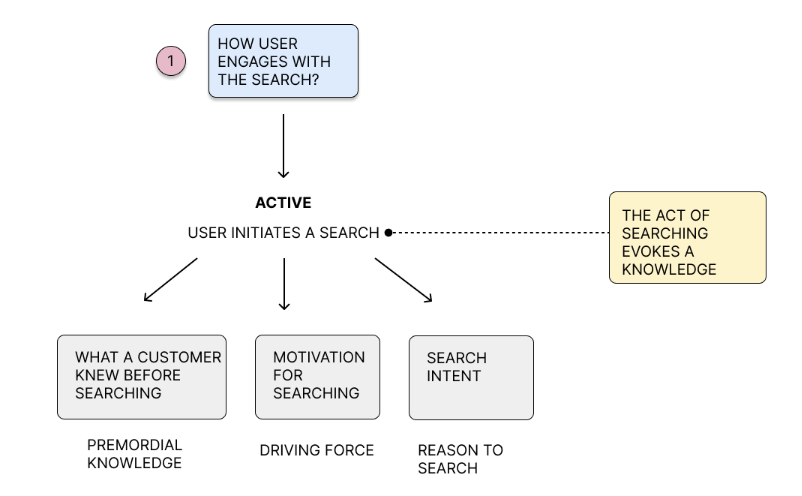
- First is asking what a customer knew before making a search. This is a primordial knowledge. This is something that has come before he put some words in a search filter or used a voice search.
- Second, what was the motivation for searching? This is to say what is the driving force behind making searches.
- And finally, as the search has the search intent, what was the actual reason to search for something?
2. Can a user make a search without any prior knowledge on the subject?
Let’s proceed to another question. Can a user make a search without any prior knowledge on the subject?
No, this is impossible. He or she must find words to formulate a query, so he at least needs to know something in order to know more. This is a thing that is particular to search engine experience, for example.
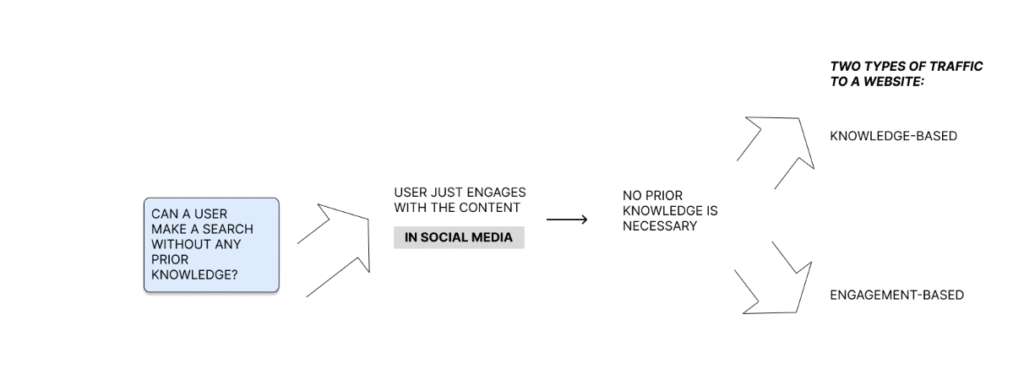
In social media, the user just engages with the content. He may start from nowhere and already have his posts appearing. When he gets engaged, the algorithm is built in such a way that it suggests a content based on the preferences or the actual things that the person makes. So here, in the social media domain, no prior knowledge is necessary.
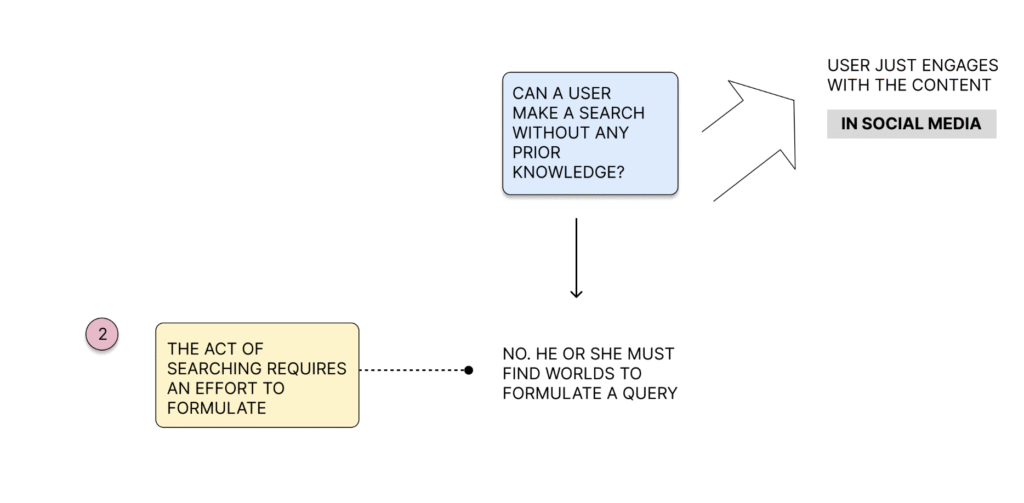
Whereas in the search engine environment, the very act of searching requires a significant effort to formulate things, to put things in words.
So this has two implications. It both:
- creates some limitations to the search from the start, and
- gives the idea of the basic funnel where a user is located.
So, a customer starts from some knowledge, which may be called incomplete knowledge and proceeds to more full knowledge, that he can gain using a certain source or on a certain web page.
3. Limitations of search
Let’s go through the limitations of the search in the first place.
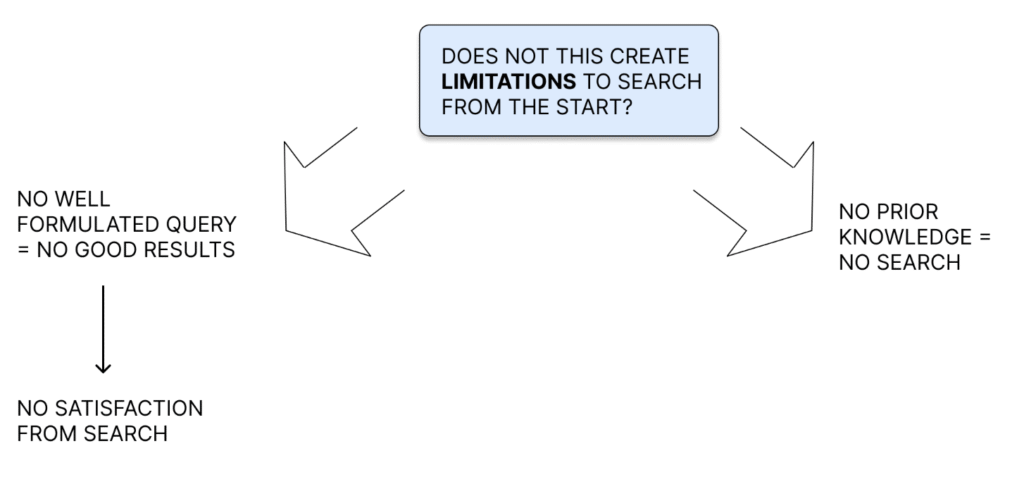
- When there is no prior knowledge, there is no search.
- When a person cannot formulate a query properly, he will not get any good results. This is to say, no satisfaction from search.
This is a very important thing because in order to get good results, you may need to have a good or proper formulation (in the first place). When it comes to query refinement or any subsequent request to the search engine, it nevertheless diminishes dissatisfaction, so the user leaves dissatisfied all the same.
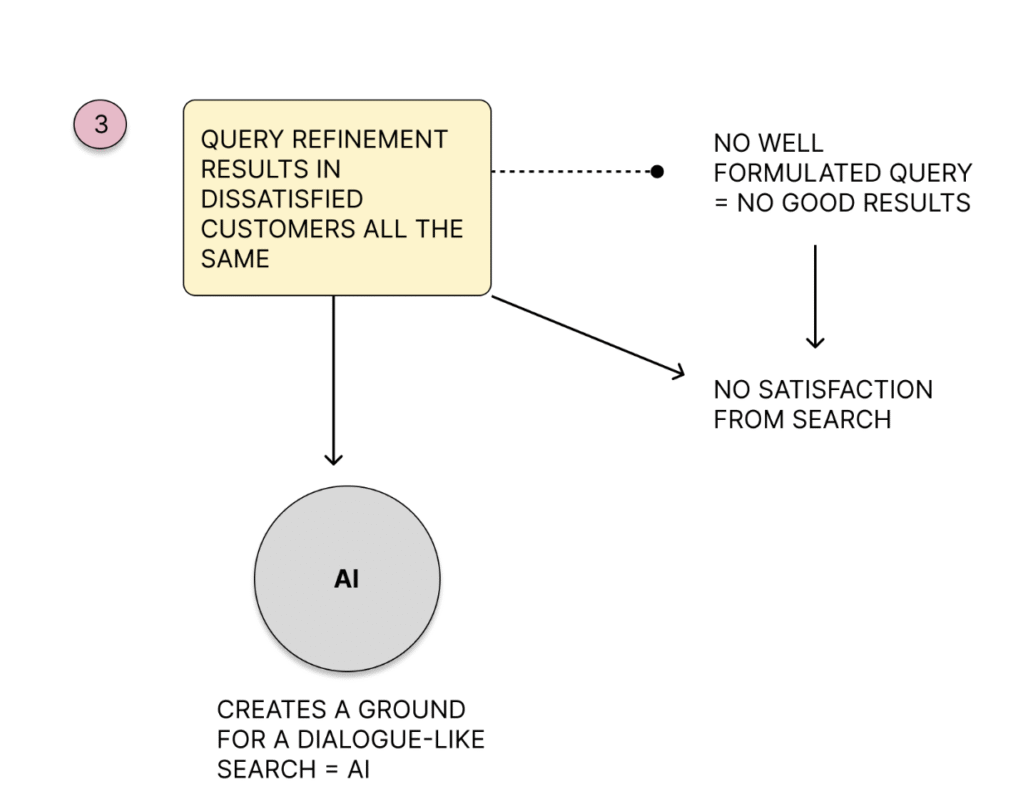
Overall, a query refinement does not help, i.e. does not solve the problem of a badly formulated query. This brings in the idea of artificial intelligence agents, which creates a ground for dialogue-like search, whereas search engines, for example, Google and Bing in its basic form, are built around one particular query, no matter what results refinement that may bring.
Proceeding from incomplete or initial knowledge to the search result that potentially may potentially expand the knowledge, a person or a customer finds himself on a webpage.
Web page is a place where at least several types of traffic meet.
- Traffic that is query- or a knowledge based.
- Traffic that is engagement-based, etc.
This is to say social media traffic any other type of traffic that may come in. So, what’s important is that despite of the variety, they come together in one place that’s called web page.
4. What is a web page?
What is special about web pages? What is a web page or a website? If we look at it through the marketing paradigm, is a place where at least two important things happen.

- It is where all the marketing experiments take place.
- It’s a place where information about a user is being gathered.
4.1. Is optimisation itself also an experiment?
So it allows for the question, If optimisation itself is also an experiment?
And we can say positively, yes, it is an experience. As long as it’s a process or as long as it’s ongoing.
Then, can several experiments coincide in time, happen in one moment of time? And again, yes, it’s highly likely.
Finally, does a page look all the same despite the traffic, despite the source of traffic, and despite the goals of experiments?
Yes, in the vast majority of cases, the website looks uniform, whatever type of traffic comes in, and whatever experiments we may think of that are happening right in the moment.
5. If experiments may potentially coincide, does not this imply an existence of a certain guiding principle?
This brings us to the question if potentially there’s a bunch of traffic sources, bunch of traffic experiments, or a bunch of optimizations coming together on one place, one page, these different kinds of optimization may potentially interfere. Doesn’t it imply a certain overarching or a guiding principle for any optimization?
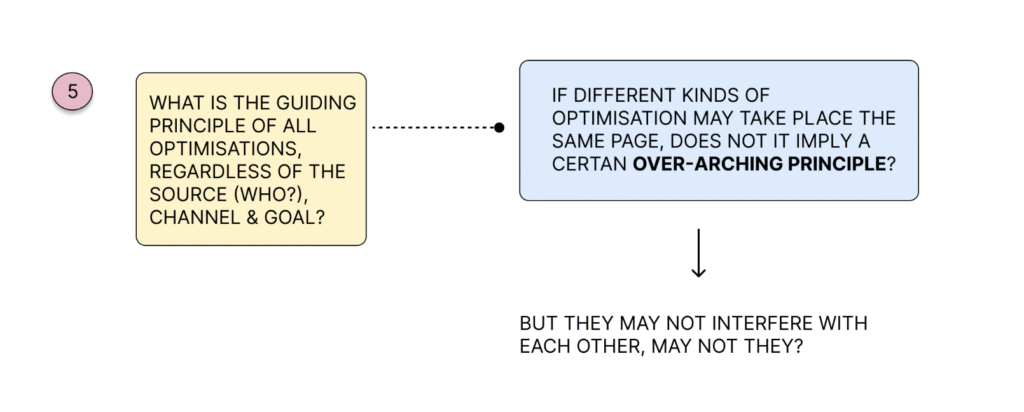
So this question is about what is the guiding principle of optimization, regardless of
- the source (who is doing the optimization),
- the traffic (where does a specific user come from),
- the goal (what is the particular page made for)?
We may say that potentially experiments may not interfere with one another, so a discussion is not fully pertinent.
Let’s make a simple hypothesis. Let’s suppose SEO postulates one thing: it requires a title’s length to be that number of characters, and for example, social optimization requires different, radically different things, for example, the title lens will be shorter or longer or different or contained images or HTML code or whatever.
So, whatever type of divergency you may think of is potentially in place on a webpage as long as it’s the same for all kinds of traffic, and it’s open for optimisations to go on simultaneously.
And in this case, you may agree that, obviously, there must be a general guiding principle of any optimization. And it’s absolutely necessary because otherwise they just conflict with each other and they will produce no good for the website or no good for the user.
6. What is a guiding principle of optimisation?
I call this principle a customer Good or customer benefit. This category of a customer’s goods may have different dimensions: moral dimensions, a dimension of choice. But its practical aspect may be called a Customer Utility. So, a customer utility may be called a guided principle for all optimisations.
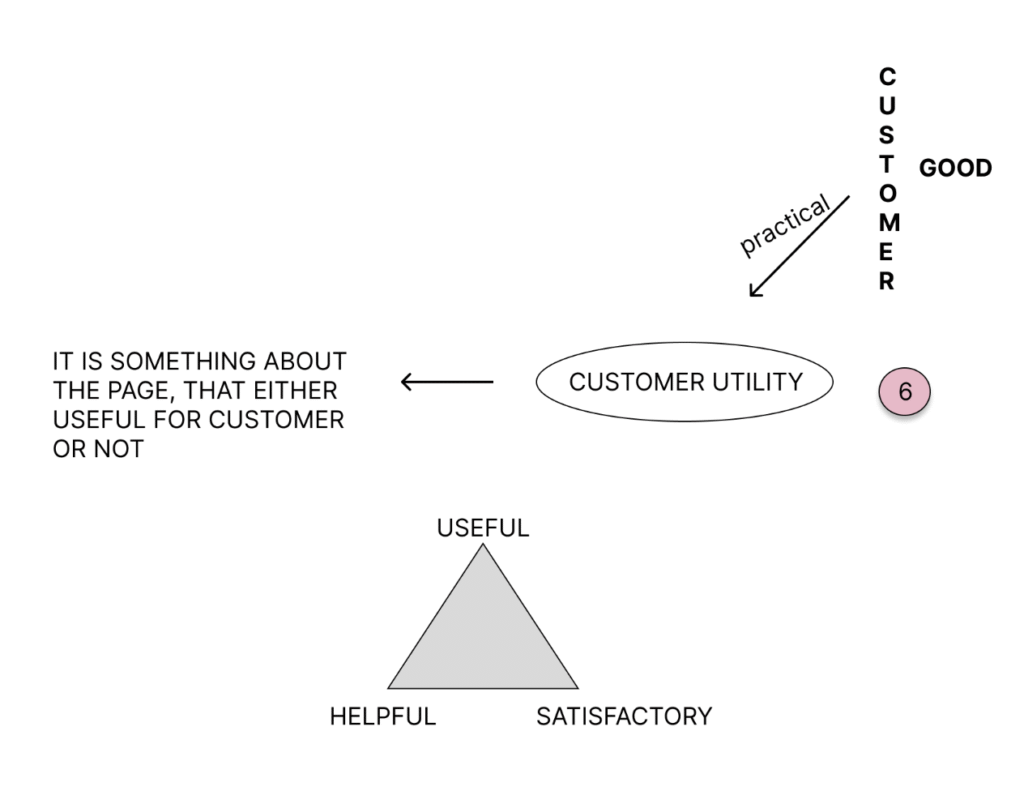
And customer utility, it is something ultimately about the page, so it’s not something about the customer himself. It’s not some kind of technical thing. It’s about the page, or about what is obvious to a customer. And it lies somewhere in the triangle of
- what is helpful,
- what is useful,
- what is satisfactory,
coming from the perceived conditions and the requirements of the customer.
7. Can a search engine alone fulfill this customer utility?
(In other words, where does this customer utility pertain? With what domain? )
Obviously, no. Customer utility does not pertain to SEO alone. Otherwise, there’s a logical fallacy here. Because otherwise any guiding principle will not be necessary.

7.1. Does customer utility pertain with any other domain?
(and it is just followed by SEO?) For example, may it pertain to marketing, product, whatever.
No, all these domains have their perspective or outlook of a customer utility, and it’s these perspectives are not the same.
Let’s consider perspective as a way to analyse and understand the customer utility.
Every domain has its own pair of eyes, its own lens to see and analyze the customer utility:
- Marketing sees through the eyes of customer sentiment and other customer data
- Product eyes try to find the implicit data, try to look for unknown motivations
- Technical eyes would look for conformity to the external explicit requirements.
And these perspectives are different, obviously.
What is the SEO perspective then?
We’ll go to this question in lesson two, but for now, let’s agree that all these different perspectives come together, meet on the specific website page, which requires alignment. Each of these perspectives has its own way of apprehending custom utility.
Let’s delineate a search engine optimization.
What is Search Engine Optimisation?
“Optimize” means increase utility according to the requirement of some process. So, a search engine optimization is increasing customer utility according to the requirements (or as seen through the lens) of a search engine, obviously under the condition that it comes to terms with the perspective of other domains.
So if we think about optimization as a mirror, this is what we see looking at this mirror through the eyes of search engines or how search engines apprehend this customer utility.
Which obviously has a limitation of:
- How is the data gathered by search engines?
- What process do they use to gather and transform this data?
- What is the goal of search engines? What is their business or existential goal? How do they work with the risks? And so.
Summary of lesson 1
Main terms: customer utility, search engine lens.
Main points of discussion:
- The act of searching evokes a knowledge
- The act of searching requires an effort, e.g. to formulate the query.
- Customers coming from different channels end up on a single site or web page.
- Since optimisation per different channels of traffic may co-occur and conflict with each other, a guiding principle is necessary.
- A customer utility is a guiding principle and an object of optimisation(s).
- SEO or Search engine optimization is optimization for a customer utility as it is implied by search engines.
Postback from Lesson 20
Customer Utility is called Customer Value later on. This concept has a specific meaning that is being developed along the course and involves Customer Value attributes and Customer Value Stream.
A search engine is the first customer that an organisation encounters: it stands first in a row and shall be satisfied in this sequence. Search engines understand the value through Ranking Signals that are algorithmically inferred from data. Customer value is what a customer wants and is willing to pay for. To that end, customers provide direct and real-time feedback that needs to be scientifically analyzed.

Leave a Reply